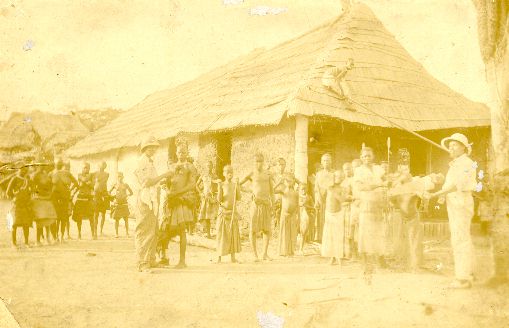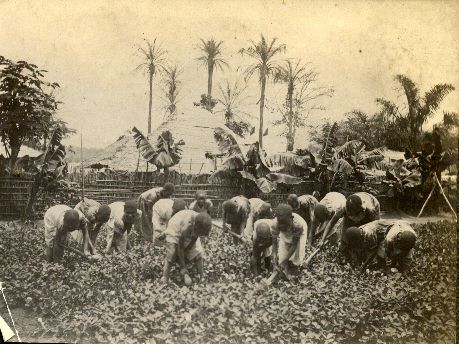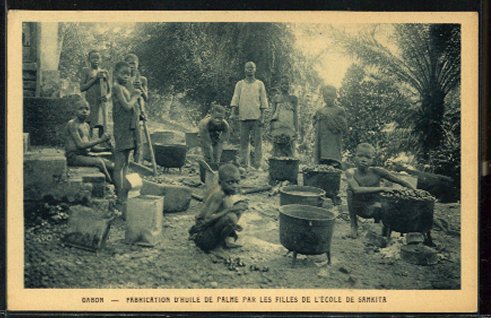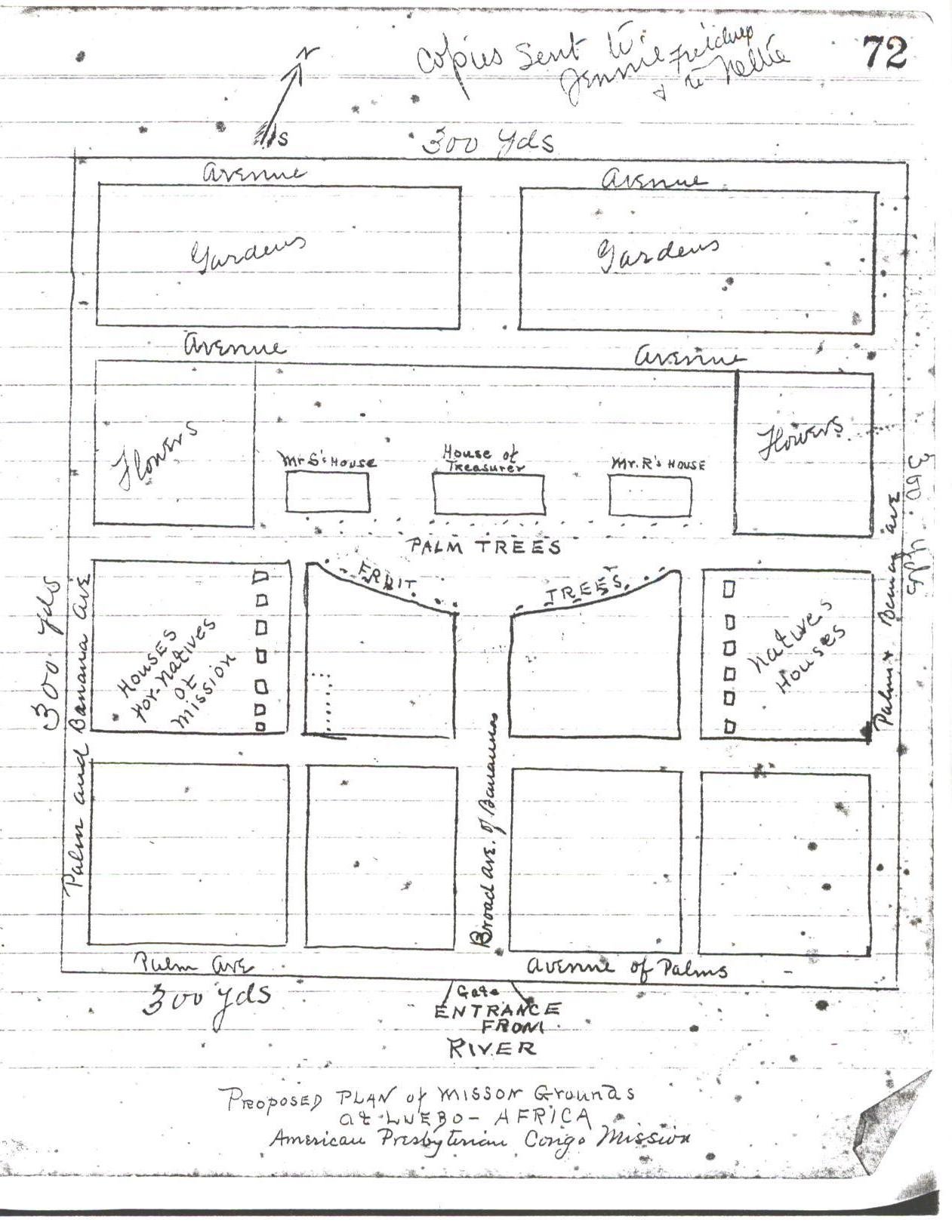
Luebo, Congo Free State
As all my letters, for the next three years, will deal principally with the place and with the missionaries connected with
it and with the natives living here and in adjacent villages, it will make things and persons better understood if I enter
somewhat into detail. I send you with this letter a plan of the station.
Africa, June 23, 1893
The mission is
situated about a mile from the river and about 200 feet above it. A beautiful path leads up to the mission through the woods, which I have described in other of my
letters, so will not repeat it here. A broad avenue 150 yards long leads from the entrance of the grounds up to the centre square, which will contain the mission
house with a missionary’s house on each side. The mission house will contain within its walls all the barter goods, the treasurers, office and the living rooms of the
treasurer and family. The avenues leading in all direction from the Central Square will be lined with Palm trees, Pineapples, Bananas, PawPaw and other tropical plants,
trees etc. Fences made of bamboo & Palm rails (if that may be called rails), will enclose all. All this of course is in embryo at present but as a part
of the mission work is to buy slaves and free them and as the “State” makes it obligatory to keep all liberated persons, not less than “ten moons” and we are in
favor of keeping them as long as they will stay, so as to instruct them and lead them to Jesus; And yet, feeling that to teach them to be lazy would be contrary to the
teachings of the Bible, some work must be given them, So build houses, clearing grounds, setting out trees etc., etc., is done by them for which they are paid weekly.
In this way will the plan as sent you gradually be developed.
Perhaps you would be interested in the money used here, the staple medium of exchange is Cowries, a shell about the size off a hazel nut brought from India I think,
100 of these are of about 5 cents value here. Next comes the wire, either brass, ivory or copper one fathom of which is worth about 10 Cowries and will buy
an egg, next come small beads two thimble fills of which are equal to 10 Cowries and will buy an egg, while about 6 thimbles full will buy a fair sized hen.
You will see by this the native looks upon a chicken as being of only 3 times the value of an egg she lays. Then cloth is used as a medium of exchange,
8 yards of unbleached muslin being =equal to about 4000 Cowries. All these prices are based on what these articles are worth plus the transport from England.
A boy or girl can be bought for 8 yards of this unbleached muslin, and a man or woman for double the amount. The nearest village to us and where we hope to do the
most of our work is the Bakete, a tribe under the dominion of the King Lukeuga of whom no doubt you have heard of through Mr. Sheppard. They are not as
interesting as we had thought from the description of read of them but we like them and feel that we can work with them. As a tribe they are lazy and do little
else than drink Mulafo, and scold their wives, and smoke tobacco - The women do all the work. They live on Manioc, (Cassava) and Indian corn, goats, chickens
and eggs. What trading they do is in rubber and ivory. The rubber of Africa is not drawn from trees, as in South America, but, from a vine belonging to the order
of Emphonbacae and which yields a good rubber and in sufficient quantities to make it pay well. It is gathered and dried into balls of about one ounce weight and
the native sells each ball for 10 Cowries. Elephants roam in this part of Africa and hence the Ivory.
Monday we had a visit from King Lukeuga’s son. He came in state. His cloth trimmed with Cowries and beads, while over each shoulder were two strings of Cowries
and his legs from the foot almost up to the knee were covered with Cowries , he must have had art least 10,000 Cowries on his person, besides the beads and brass
bangles his body was stained a turkey red by using a dye made from the Cain wood. He was attended by about two subjects. He brought us half a dozen fowls as a
present (“Macebish”), and of course expected from us a present of greater value. We gave him one piece, 8 yds, unbleached muslin and a few beads and the palaver
was finished. Then Mr. Adamson took his picture, which I hope to send to you someday and he was shown over the premises. The clock was an astonishing wonder to
him and called forth a hearty “M'leugala” (good), but when Mrs. Snyder played a tune on the organ for him his astonishment was greater.
Yours, D W Snyder  Now a moment given to the missionaries. First the Rev. W. H. Sheppard, who at this writing is in America, with whom you are all well acquainted, is as you know
a colored man from America. Mr. & Mrs. Adamson, Scotch English. And Mr. & Mrs. Rowbotham, and the writer and his wife. We must not omit Mr. Ockels who, we
hope, is now nearing Matadi and for whom we look to come on the next boat.
(1895, building the church - Sheppard right)
Now a moment given to the missionaries. First the Rev. W. H. Sheppard, who at this writing is in America, with whom you are all well acquainted, is as you know
a colored man from America. Mr. & Mrs. Adamson, Scotch English. And Mr. & Mrs. Rowbotham, and the writer and his wife. We must not omit Mr. Ockels who, we
hope, is now nearing Matadi and for whom we look to come on the next boat.
(1895, building the church - Sheppard right)
 (Native children in peanut patch)
We have at present 74 natives belonging to the mission, this includes 27 Children under fifteen years old. It would not be interesting to give their names to you,
but one or two have become so identified with the mission since the time of Mr. Lapsley, that their names will always be of interest to your readers. I refer to
Ngululu and Ntombe , others from time to time will appear as characters and will claim a share of your interest. One we would like to introduce now, our personal
boy David, a bright energetic boy of ten or thereabouts. Already he has won our hearts even as the David of old won the heart of Johnathen. God grant that he,
our David, may soon learn to say as David. The Lord is my shield and buckles, I will trust in him at all times. Now having introduced those who will figure
in my future letters, and those directly around us subject to most direct influence, let me tell you of the working of the mission before telling of the village
and more remote villages. And in describing this working I mean to put in a few things as though they were being done, while in reality they are not at present
in working order, but undoubtedly, God willing, will be, long before this reaches you.
(Native children in peanut patch)
We have at present 74 natives belonging to the mission, this includes 27 Children under fifteen years old. It would not be interesting to give their names to you,
but one or two have become so identified with the mission since the time of Mr. Lapsley, that their names will always be of interest to your readers. I refer to
Ngululu and Ntombe , others from time to time will appear as characters and will claim a share of your interest. One we would like to introduce now, our personal
boy David, a bright energetic boy of ten or thereabouts. Already he has won our hearts even as the David of old won the heart of Johnathen. God grant that he,
our David, may soon learn to say as David. The Lord is my shield and buckles, I will trust in him at all times. Now having introduced those who will figure
in my future letters, and those directly around us subject to most direct influence, let me tell you of the working of the mission before telling of the village
and more remote villages. And in describing this working I mean to put in a few things as though they were being done, while in reality they are not at present
in working order, but undoubtedly, God willing, will be, long before this reaches you.
At half past six A. M. the gong rings and all the natives assemble in the Chapel,
(at present the Chapel is under Mr H. S. Verandah) Roll is called, a song is sung, the Lord’s Prayer recited in unison, a song, a prayer and the benediction.
All sick are reported
to Nganga Buke, (the doctor who at present is the writes). The rest go to Mr. Rowbotham who gives out the days work while Mr A our treasure attends to his work
and helps all around. He is in great demand and will be until we learn the language.
Every day there is two sessions of schooling over which the ladies preside. Prayer meeting Wednesday and Sunday evenings, and general worship at the village
Sunday morning where a sermon is delivered. After a while we will have daily school at the village and all patients treated there.

 (Palm Oil Factory)
Palm oil is not gathered in this part of Africa as the distance from the coast makes the transport, cost more than the oil is worth but when the rail road is
complete then the palm oil industry with other industries will
open up. Still I think the success of Congo Land will rest upon the supply of rubber, should that fail, it would hardly pay to come so far for other articles.
(Palm Oil Factory)
Palm oil is not gathered in this part of Africa as the distance from the coast makes the transport, cost more than the oil is worth but when the rail road is
complete then the palm oil industry with other industries will
open up. Still I think the success of Congo Land will rest upon the supply of rubber, should that fail, it would hardly pay to come so far for other articles.
Some very fine and valuable timber is growing all around here but is as valueless at present as was the black walnut trees on the plains of Iowa sixty years ago -
It is a question whether this timber well ever be used, as for gardening and farming I can not speak positively as yet.
Corn grows here and does exceedingly well.
Vegetables will do as well as they do in Florida. The native subsists on corn meal, Chumbie, (a flower or paste
made from Manioc) Bananas, Plantuis, and Palm oil and palm nuts. A quantity of peanuts too are consumed yearly. Fish are scarce and command a good price,
wild game, for eating, is scarce. What can be used consists of wild pigeons, Ginny hens, parrots and monkeys. I have not tried the last two named so cannot
speak of their merits or demerits.
We went out to shoot a monkey the other day but could not get close enough too him, he had come within a short distance of the house, but retreated fast as we advanced.
He as was large as a five year old boy, and had a white spot on his head that gave him the appearance of wearing a cap. We are free form snakes I think as not one has
been seen since out arrival.
In my next letter I will be able to tell you more about the peanuts, trees, insects, birds and beasts. And I hope much more
about the people and their work and our work. There are fairly good black smiths, weavers, carvers and mat makers among them. They make beautiful cloth woven from
thread made from the bud of the Palm tree and dyed in colors and woven to a pattern; the design is
Then I sewed a seam on our sewing machine to show him how that worked. I wish I could show you his picture as he looked when he saw how neatly and quickly
by the machine did it work . He has told Mr. Adamson that his (the prince’s) heart is the same as r. Adamson’s, which means that the prince loves Mr.
A like his own brother. He has invited him to go and visit Lukeuga. Mr. A & Mr. R expect to go soon.
My work with the sick will keep me here for the present.
And now having introduced you to our station and the people I will close. I hope to send you another letter by the next boat which will leave here next October.
If you do not hear from us don’t worry, we are away from civilization and get letters only twice in a year.


as the plan for the mission:


